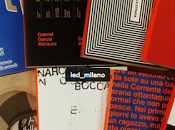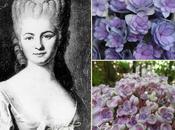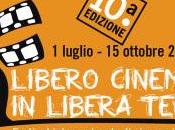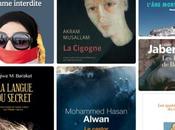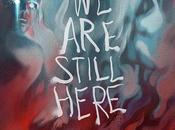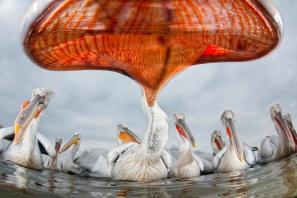
Pelican perspective © Bence Máté / Veolia Environnement Wildlife Photographer of the Year 2011
Wildlife Photographer of the Year 2011 - Il premio – dal 1964 – che è senz’altro il più prestigioso al mondo, in questa edizione ha visto la partecipazione di oltre 40.000 concorrenti provenienti da ogni luogo della Terra. Dal 28 gennaio all’8 maggio 2012, il Forte di Bard (click: MAPPA), principale polo culturale della Valle d’Aosta, ospita la prima tappa italiana del tour mondiale della mostra fotografica Wildlife Photographer of the year 2011. L’esposizione raccoglie oltre cento immagini, vincitrici nelle 17 categorie del concorso indetto dal Natural History Museum di Londra in collaborazione con il BBC Wildlife Magazine. A MAE Milano Arte Expo è risultato veramente arduo scegliere le immagini che corredano questa segnalazione tra la moltitudine di foto straordinarie che potrete godere direttamente al Forte di Bard. >
Gli scatti di fotografi dilettanti e professionisti famosi del concorso giunto ormai alla sua 47esima edizione sono giunti per la prima volta anche da paesi come Cambogia, Moldova, Brunei e Kirghizistan. Si è assistito, inoltre, a un ragguardevole aumento delle fotografie inviate da India, Cina e Russia. In ognuna delle categorie, sono stati selezionati i vincitori da una giuria di stimati esperti e fotografi naturalisti.
-
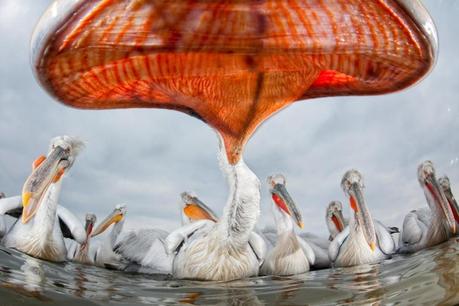
Pelican perspective From his kitchen table, Bence planned the way he would photograph Dalmatian pelicans. He wanted a water-level perspective of them. So he designed and constructed a catamaran-style floating system, incorporating an underwater camera housing and specially positioned lights and flashes, and set off for Lake Kerkini in northern Greece. ‘It was a huge buzz,’ says Bence, ‘to find that the contraption actually worked.’ Using cables, Bence took photos from a distance away on a boat, monitoring the scene on a screen and altering the settings with the ever-changing light. The fish-eye lens gave the unusual perspective of the pelican’s pouch as it caught a fish thrown back into the lake by a fisherman. © Bence Máté / Veolia Environnement Wildlife Photographer of the Year 2011 Nikon D300S + Tokina 10-17mm f3.5-4.5 lens; 1/160 sec at f16; ISO 500; Subal housing; three linked SB-800 flashes; floating remote-control system.
-
Il premio più ambito, il Veolia Environnement Wildlife Photographer of the Year, è stato conferito al fotografo spagnolo Daniel Beltrà per la sua fotografia Still life in oil, dal suo portfolio per il Wildlife Photojournalist of the Year Award. L’istantanea, che cattura otto pellicani messi in salvo dalla marea nera a Fort Jackon in Louisiana, colpisce per la sua semplicità che la rende bella e impressionante allo stesso tempo.
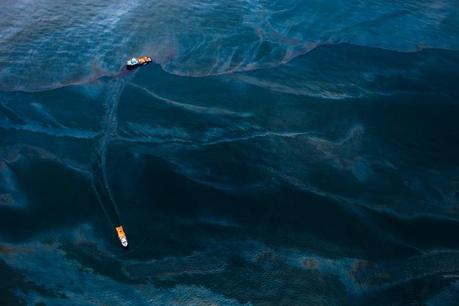
Toxic beauty ‘This is what the oil spill mostly looked like, for miles and miles, from one corner to the other,’ says Daniel. ‘Visually, the textures, hues and patterns of the oil were striking.’ Asked why he made images of the oil spill that look beautiful, he answers, ‘It was not my original intention, but photographs of disasters are often harsh. This set of images wouldn’t look out of place in an art gallery, where families could look at them and discuss them. It’s a route to understanding that doesn’t depend on shock. I think it helps get the message to a wider audience, because if the image is aesthetically appealing, people are more likely to stop and read the caption.’ © Daniel Beltrá/ Veolia Environnement Wildlife Photographer of the Year 2011 Canon EOS 5D Mark II + 35mm f1.4 lens at 35mm; 1/1000 sec at f5.6 (-0.7 e/v); ISO 250.
-
Il Veolia Environnement Young Wildlife Photographer è stato vinto dal polacco Mateusz Piesiak, con Pester Power nella categoria 11-14 anni. La foto ritrae una giovane beccaccia di mare mentre cerca di strappare un pezzetto di cibo ad un esemplare adulto. La giuria è rimasta impressionata dalla grande abilità tecnica del fotografo, soprattutto data la sua giovane età.
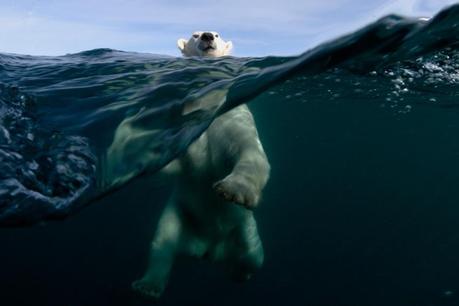
Polar power After three days on a small boat looking for polar bears in Repulse Bay, Nunavut, Canada, Joe finally got lucky. ‘We cruised at a distance, so we didn’t disturb the bear. Then, once we were sure it was relaxed with our presence, I slipped quietly into the water with just a mask and fins, attached to the boat by a rope.’ The polar bear now started to swim towards the boat, powering itself with its front legs, the toes of its huge paws spread wide. It didn’t appear to notice Joe, and for 20 minutes he was able to take photographs from the water. But then the bear caught sight of its own reflection in the dome port and swam up to Joe. ‘It’s amazing when a huge, powerful animal comes beside you.’ It came so close that its nose touched the housing, startling it. The second after Joseph took this shot, the bear reached out and touched the dome with its paw. Then it turned and swam away, leaving Joe with an unforgettable split-level image of a swimming polar bear – symbolic, he says, ‘of the power and elegance of a wonderful creature struggling to survive in a fast-changing climate.’ © Joe Bunni/ Veolia Environnement Wildlife Photographer of the Year 2011 Nikon D2X + 10.5mm f2.8 fisheye lens; 1/320 sec at f12; ISO 400; Aquatica housing.
-
Anche due fotografi italiani sono stati eletti vincitori di altrettante importanti categorie fotografiche. Marco Colombo, di Varese, ha vinto il premio nella categoria Ritratti di animali con la sua Sinuosità. L’opera definita dalla giuria una composizione affascinante, è stata scattata in Lombardia, ed ha per protagonista una natrice femmina, immortalata accanto ad un bellissimo ruscello. Il valdostano Stefano Unterthiner invece, si è aggiudicato ben due riconoscimenti: con la sua fotografia Illusione, si è piazzato al primo posto nella categoria Visioni creative della natura, mentre Disposizione di cigni ha ricevuto una menzione speciale nella categoria Ritratti animali.
In questa edizione il Forte di Bard ha voluto abbinare alla mostra un’iniziativa benefica a sostegno di un’associazione impegnata nella lotta contro le sevizie sugli animali. Parte dell’incasso verrà devoluto all’associazione Animals Asia Foundation a favore del Progetto “Salviamo gli orsi della Luna” che avrà uno spazio specifico anche in mostra. In tutta l’Asia migliaia di Orsi della Luna sono rinchiusi per anni in gabbie minuscole che non consentono alcun movimento al fine di estrarne la bile con scopi commerciali. Il ricavato finanzierà la campagna volta alla chiusura di queste ‘fabbriche della bile’ e alla liberazione e reinserimento degli orsi in riserve protette.
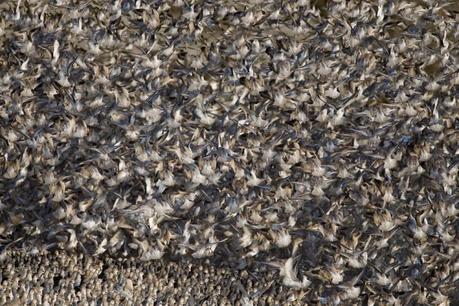
Thomas Hanahoe UK 026 Knot lift-off The bleak mudflats of the Wash Estuary in Norfolk provide an enormous feeding table for waders. As the tide comes in, the flocks are flushed inland. To catch the spectacle, Thom set up on Snettisham beach just before dawn. ‘I watched as, in the distance, hundreds of thousands of wading birds took to the air, swirling in unison before swooping low over the shore to settle on the beach,’ he says. Tens of thousands of knots roosted together, ‘their heads aligned like spectators at a sports event’. But with the arrival of a marsh harrier, all hell let loose. ‘The knots erupted into a wall of wings, and the air filled with an intense crescendo of calls. As the wave of birds started to ascend, I pressed the shutter.’ © Thomas Hanahoe/ Veolia Environnement Wildlife Photographer of the Year 2011 Canon EOS-1DMark IV + 500mmf4 lens + 1.4x extender at 700mm; 1/2500 sec at f5.6; ISO 1600.
-
Wildlife Photographer of the Year 2011
a cura del London Natural History Museum e di BBC Wildlife Magazine
in collaborazione con Forte di Bard
Gli scatti più belli della fotografia naturalistica al Forte di Bard
Forte di Bard. Valle d’Aosta 28 gennaio – 8 maggio 2012
Inaugurazione: venerdì 27 gennaio 2012 ore 18.00
Gli eventi collaterali:
. I comportamenti animali negli scatti di Wildlife 2011
Venerdì 2 marzo 2012
Ore 21.00 Salone manifestazioni Palazzo Regionale. Aosta
Giuseppe Bogliani professore di Scienze e tecnologie per la natura presso l’Università di Pavia approfondirà gli aspetti più salienti legati alle specie animali e vegetali ritratte nelle immagini presenti in mostra. Nel corso della serata interverranno anche esponenti dell’associazione Animals Asia Foundation impegnata nella tutela degli Orsi della Luna cui è dedicata l’iniziativa benefica legata alla mostra.
Ingresso gratuito su prenotazione.
. Il portfolio di tre fotografi wildlife
Venerdì 4 maggio 2012
Ore 21.00 Salone Biblioteca Comprensoriale. Châtillon (Ao)
I fotografi naturalistici Daisy Gilardini, Stefano Unterthiner e Marco Spataro saranno i protagonisti di una serata interamente dedicata alla fotografia wild.
Ingresso gratuito su prenotazione.
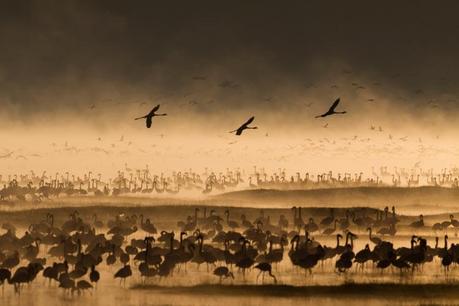
Paul Goldstein UK 032 Taking flight Paul arrived very early on the shores of Lake Nakuru, Kenya, before the rising sun had burnt off the mist. He had returned to photograph the greater and lesser flamingos and used shade, shadows and silhouettes to create drama, rather than sunlight to emphasize their vivid colours. He was helped by a combination of circumstances: rain during the night, a rapidly clearing sky, enough time for the cold air to form mist over the alkaline waters and a hyena hunting for young or infirm birds along the far shore of the soda lake. The predator set up a wave of panic, with those closest to it taking flight and those nearest to Paul standing alert. Ten minutes later, not only had the whole flock lifted up, but the mist had also burnt off, completely changing the scene. © Paul Goldstein/ Veolia Environnement Wildlife Photographer of the Year 2011 Canon EOS-1D Mark 4 + 500mm f4 IS lens; 1/5000 sec at f10 (-1.7 e/v); ISO 200; beanbag.
-
. Forte di Bard Professional Education: Master of Wildlife Photography
Sabato 5 e domenica 6 maggio 2012
Il Master, con modalità residenziale, offre un percorso formativo altamente qualificato con professionisti del settore, dedicato all’approfondimento delle tecniche di fotografia naturalistica, alla lettura del portfolio dei partecipanti e all’utilizzo degli strumenti di fotoritocco. Le lezioni saranno curate da Daisy Gilardini, Stefano Unterthiner e Marco Spataro.
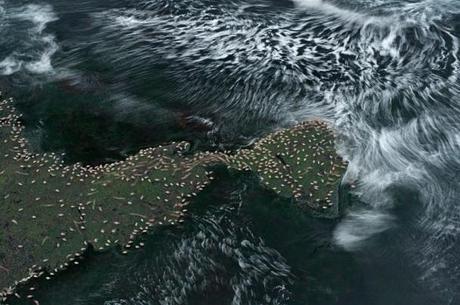
Erlend Haarberg NORWAY 017 A wave of waders In spring, thousands of red knots stop off in Iceland, on their way from Western Europe to their breeding grounds in Canada and Greenland. From the windy top of a cliff in Snæfellsnes, on the west coast of Iceland, Erlend watched the feeding flock and planned his picture. ‘Everything was moving. The birds were scurrying to and fro, and powerful waves were crashing in,’ says Erlend. He wanted to show the power of the sea and the resilience of the birds, and over seven evenings, he experimented with different shutter speeds and perspectives, trying to keep the tripod from being blown over. He needed three things: high tide, so that any birds would be corralled up the shore rather than scattered; waves big enough to create a graphic pattern but not so big that the knots would fly off; and early-morning or late-afternoon light so he could use a long shutter speed and capture the movement of the waves. His planning paid off. © Erlend Haarberg/ Veolia Environnement Wildlife Photographer of the Year 2011 Nikon D700 + 24-70mm f2.8 lens; 1/6 sec at f7.1; ISO 400; Gitzo tripod.
-
Eventi su prenotazione.
Master: T. 0125 833886
Conferenze: T. 0125 833826
Info
Associazione Forte di Bard
Bard. Aosta
T. + 39 0125 833811
F. + 39 0125 833830
[email protected]
fortedibard.it – facebook.com/fortedibard
Orari:
martedì/venerdì dalle ore 11.00 alle 18.00
sabato/domenica e festivi dalle ore 10.00 alle 19.00 – chiuso il lunedì.
Tariffe: intero 5 euro – ridotto 3 euro – gruppi/scuole: 3 euro
Cumulativo con la mostra I tesori del principe: 12 euro
Ufficio Stampa
Associazione Forte di Bard
Amelio Ambrosi T. + 39 0125 833824 [email protected]
SPAINI & PARTNERS T. 050 36042 – spaini.it – [email protected] – [email protected]

